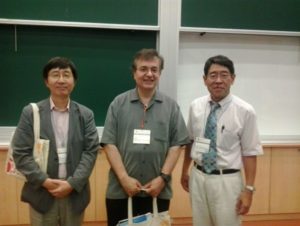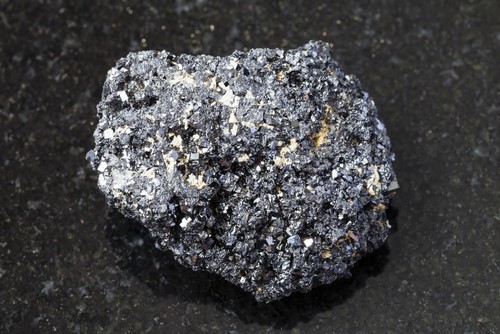admin | 26/11/2019
The growing global demand for electricity makes it essential to develop alternatives to fossil fuels, both to face the upcoming energy supply shortage and to stop the effects of climate change. Renewable energies, as an inexhaustible natural source, are the key to this industry’s future, and solar energy in particular is one of the most promising segments. Until now, silicon has been the material used most in construction of solar panels, but there have been advances and new lines of research related to a very promising material: perovskite.
According to the International Energy Agency (IEA), the energy load from renewable sources will double its capacity in the coming five years, driven primarily by the increase of photovoltaic solar electricity. Growth in this market is unstoppable and is still far from reaching its limit. The progressive decrease in costs of production and distribution as well as the commitment by the major world powers to promoting clean and inexhaustible sources make them a sure bet for the future.
Progressively more households, businesses, and industrial facilities are equipped with distributed generation facilities, which represents a paradigm shift in providers and, as a result, a major challenge for the sector. This energy transition has also been an opportunity for alternative solar development and research. Until now, silicon has dominated the photovoltaic market, but in recent years major steps have been taken toward perovskite, a material that is less expensive, more accessible, and efficient—with silicon, just 20% of solar energy is converted to electricity. Pedro Atienzar, senior scientist at the Spanish National Research Council (CSIC), and Juan Bisquert, director of the Advanced Materials Institute (INAM) at the Universitat Jaume I, spoke with us about this compound’s potential in this new scenario.
From silicon to perovskite

Some of the discoverers of perovskite as a photovoltaic material: Nam-Gyu Park, Mercouri Kanatzidis, and Tsutomu Miyasaka (2013).
Today, most photovoltaic panels are made of silicon, a component with semi-conductive properties that work to convert energy from the photons present in sunlight into electricity. This environmentally friendly process is based on cells that act as intermediaries. “It is true that silicon technology has been known for several decades and is widely implemented,” said Pedro Atienzar. “Its cost has been reduced drastically in recent years, making it a technology that is difficult to beat.” However, the search for more economical and efficient alternatives has been underway for some time. Perovskite is showing promising signs of being the key to producing photovoltaic cells with clear advantages over silicon.
But what exactly is hidden in this term? In the field of energy, perovskite no longer refers to the mineral discovered by Gustav Rose in the 19th century in the Ural mountains. It is not even a single material. “It is a chemical structure that has been known for a century, a ternary compound with atoms that take on an octahedron form, with a larger atom inside and another type of molecule or atoms outside. Because it is a combination of three things, there are millions of variants,” explained Juan Bisquert, who added that, “in the photovoltaic field, the revolution came about with the discovery of the extraordinary properties of perovskite comprising lead (Pb), iodine (I), and methylammonium (MA).” The person behind this discovery was Japanese scientist Tsutomu Miyasaka who, more than a decade ago, revealed the amazing properties of the perovskite. Shortly after that, other researchers, including Henry Snaith and Nam-Gyu Park, began achieving noteworthy results in converting sunlight to electricity. “The scientific community realized that something extraordinary was going on,” Bisquert said, “and since then this research has become one of the fields with the greatest impact worldwide. Now thousands of articles are published each year.”
If the current obstacles can be overcome, perovskite could become a revolutionary element in the field of solar energy.
Properties and applications
There are certain contextual qualities benefitting perovskite. It can be found in mountains nearly anywhere on the planet; it is abundant, and it can be mined inexpensively and free of emissions. As Bisquert explained, for perovskite as a compound (hybrid), “it can be formed with low-temperature chemical methods from common materials, producing extraordinary optical-grade layers and electronics. This is a fact without precedent Normally, without making high-quality crystals—at thousands of degrees in a furnace like silicon and high-vacuum processes—the films do not reach the necessary quality. Perovskite does, through preparation by fluid means.” That is why the material processing—the amount of energy required to produce a silicon cell—is more expensive and complex compared to the process of a perovskite cell.
As regards the intrinsic benefits, perovskite has excellent optical, electrical, and magnetic properties, as Pedro Atienzar noted. “For example, superconductivity, when bismuth or copper are present, non-linear optical properties when they contain neodymium or tantalum, or dielectric characteristics with titanium or zirconium. Currently, a variety that is having a considerable impact in the field of renewable energies are halogenated hybrid perovskites, which contain an organic cation and halogens in the structure, giving them exceptional properties to absorb and turn radiation from the solar spectrum into electricity.” “It is an excellent semiconductor,” Bisquert stated, “with ideal optical properties, both in absorbing light and generating light in LEDs. Unlike classic semiconductors with those characteristics, it is a material that can be considered soft, with weak links, ease of internal vibrations, generating numerous new physical developments followed by numerous open possibilities.”

Perovskite is a material that can be considered soft, with weak links, ease of internal vibrations, generating numerous new physical developments followed by numerous open possibilities.
Although it is currently attracting great interest and is undergoing continual progress, perovskites have been used for many years in a variety of applications, such as applications containing oxygen in the structure. They are used in solid oxide fuel cells due to their ionic-electronic transfer and catalytic properties. However, according to Pedro Atienzar, “the perovskites that are becoming most important are the types with halogens instead of oxygen in their structure. At present, their certified efficiency in the laboratory is above 23%,” although he clarified that “despite these data, the main limitation for their commercial use is stability. A solar panel should normally last several decades, but solar cells based on these materials degrade easily when exposed to humidity, temperature, oxygen, and light, even when using a good encapsulant.”
Lines of research and industry challenges
With such a notable obstacle, many lines of work are dedicated to finding the chemical compound that makes perovskite more stable in operating conditions, which could contribute to this material providing electricity in any country in the world, regardless of their degree of development. “Environmental conditions greatly affect its formation. So if that is not taken into account, it is difficult to reproduce,” explained Atienzar. “We currently have two lines of research open with these two materials. The first is focused on their use as photocatalysts, using solar radiation to turn water and CO2 into fuels. In the other, in the field of photovoltaic energy, we are conducting studies at the microcrystalline level to determine the mechanisms that control light absorption and as a result improve the efficiency of this type of solar cells.” His team is also conducting a project to create photocatalysts based on halogenated hybrid perovskites that, “although they may be unstable in contact with water, their use in certain reaction conditions could enable these materials to become materials with significant activity.” Similarly, studies are underway on their use “to turn CO2, currently considered an undesirable and harmful waste for the planet, into added value products.”
For his part, Juan Bisquert told us about the research carried out at the Advanced Materials Institute on hybrid perovskites, which began in 2013. “This is a fascinating field that has enabled us to use our knowledge of optoelectronic devices’ properties, and we have made significant contributions to the field of research,” he confirmed. In 2008, three researchers—in addition to Bisquert himself—appeared on the exclusive “Highly Cited Scientist” list, which is almost unprecedented.
All these advances, and the necessary commitment to renewable energy sources, can make perovskite into the great energy alternative. “It could be a revolution in the sector, not only due to its low cost and the availability of the precursors, but because it could easily be placed on a wide variety of surfaces and even on construction material,” clarified Pedro Atienzar, who concluded by saying that, “if we can overcome the current obstacles, it is an element that could transform the solar energy field.”
Article collaborators…

Pedro Atienzar is the senior scientist at the Spanish National Research Council (CSIC). He studied Chemical Engineering at the Universidad Politécnica de Valencia (1996-2002) and completed his PhD at the Chemical Technology Institute (UPV-CSIC) under the supervision of Professor Hermenegildo García. He went on to carry out two years of postdoctoral research (2007-2009) in the group of Prof. Jenny Nelson in the Department of Physics at the Imperial College London in the field of photovoltaic, hybrid, and polymeric devices. In 2009, he joined the Chemical Technology Institute (ITQ) where he headed the “Nanomaterials for Photonics, Optoelectronics, and Energy” group. He is the coauthor of some 70 articles in high-impact international journals and joint inventor on 6 patents.
 Juan Bisquert is a professor of applied physics and director of the Advanced Materials Institute (INAM) at the Universitat Jaume I. He has authored over 400 scientific articles and a series of three books that include the general text “Physics of Solar Cells: Perovskites, Organics, and Photovoltaics Fundamentals.” He is currently Senior Editor at the Journal of Physical Chemistry Letters. In 2019, he was selected as one of the world’s Highly Cited Researchers (second in the region of Valencia), and he has mentored over 30 researchers. Bisquert’s research has always been characterized by intensive contacts and international relations, and he has earned recognition both nationally and internationally. He was a guest professor at Hanyang University (Seoul, South Korea) and at King Saud University (Riyad, Saudi Arabia). He is chairman of the Scito Foundation—which organizes international scientific conferences in the area of materials for renewable energies—and he conducts experimental and theoretical research into materials and devices to produce and store clean energy.
Juan Bisquert is a professor of applied physics and director of the Advanced Materials Institute (INAM) at the Universitat Jaume I. He has authored over 400 scientific articles and a series of three books that include the general text “Physics of Solar Cells: Perovskites, Organics, and Photovoltaics Fundamentals.” He is currently Senior Editor at the Journal of Physical Chemistry Letters. In 2019, he was selected as one of the world’s Highly Cited Researchers (second in the region of Valencia), and he has mentored over 30 researchers. Bisquert’s research has always been characterized by intensive contacts and international relations, and he has earned recognition both nationally and internationally. He was a guest professor at Hanyang University (Seoul, South Korea) and at King Saud University (Riyad, Saudi Arabia). He is chairman of the Scito Foundation—which organizes international scientific conferences in the area of materials for renewable energies—and he conducts experimental and theoretical research into materials and devices to produce and store clean energy.





